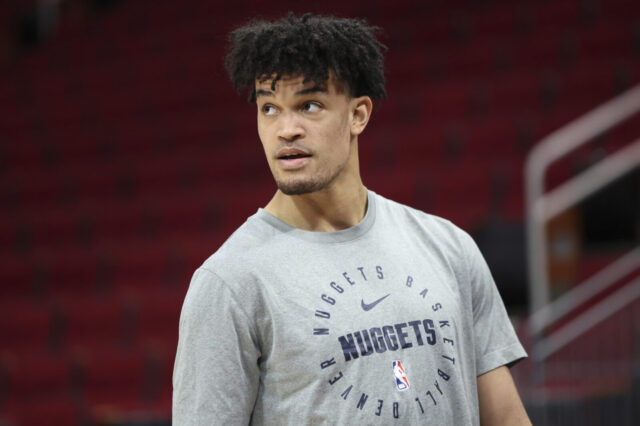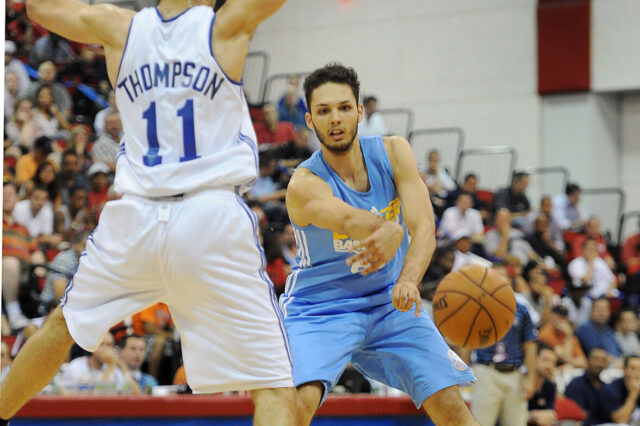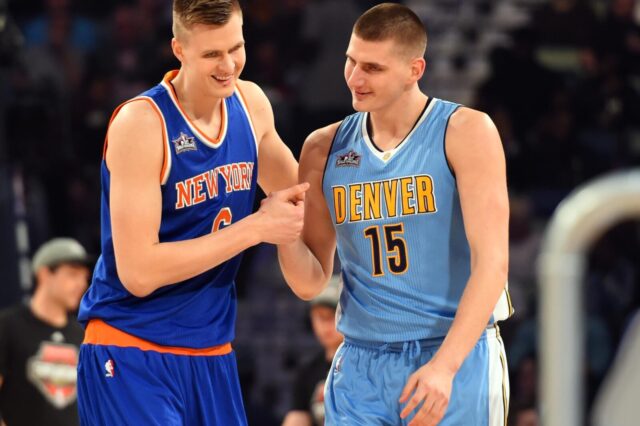The Denver Nuggets are decidedly all-in on their young point guards in Jamal Murray and Emmanuel Mudiay. After waiving Jameer Nelson before the start of the season, the Nuggets sent an early message to their team that they had faith in the young backcourt duo. Rumors about an Eric Bledsoe-to-Denver trade hovered overhead for the first few weeks of the season, but with him off to Milwaukee and off of the market, the Nuggets are set to live or die by their two talented-but-struggling point guards.
Mudiay in particular is such a unique talent. His positives are really positive and his negatives are really negatives. He’s been the best player on the floor at times and was the MVP of the game in Atlanta, almost single-handedly willing the team to victory. He’s also been the worst player on the floor, costing the team huge runs that have sometimes been insurmountable.
Let’s take a closer look at what Mudiay can do to better tap into his potential in this week’s spotlight.
This content is no longer available.
Mid-Range
Most of what Mudiay needs to do in order to improve as a player comes down to decision-making, and not necessarily in complicated situations. Mudiay can easily reduce or eliminate those possessions where he sets himself up for failure. The first and perhaps easiest adjustment is to focus on his mid-range attempts.
This season, Mudiay is shooting just 29.2% on two mid-range attempts per game. It’s especially egregious when the Nuggets go to their 2nd quarter lineup with Nikola Jokic and Kenneth Faried in the front court and Will Barton and Malik Beasley out on the wing. Last season, lineups like this were a huge plus for the Nuggets. Jokic, when surrounded with three shooters and an offensive rebounding force like Faried, is a very dynamic combination that should provide rapid ball movement, spacing, and offensive rebounding. At roughly 30%, a Mudiay pull-up mid-range jumper is among the worst possible outcomes for these types of lineups.
And this isn’t unique to this season. Last year Mudiay shot 30.3% from mid-range. His rookie season he shot 30.8%. Mudiay can improve from that zone over the course of his career but he has to learn that these types of shots should either be a last resort or only taken when he has offensive rebounders in position for a putback.
Chaos Mudiay at the rim
Most of what can be said of Mudiay in the mid-range can also be said about his shots at the rim. He is very aggressive at getting to the rim, taking the 3rd most attempts in the restricted area of all Nuggets players. However, he’s converting them at a team-worst 50%. Once again, this is a trend. In both his rookie and sophomore seasons, Mudiay had the worst FG% at the rim of all rotation players on the roster.
Some of this is just Mudiay’s nature. He’s a very aggressive player and the Nuggets desperately need guys who are aggressive at challenging the defense. However, he lacks the explosiveness to finish over the rim protector and often lacks the touch to finish though minor contact or to adjust in the air.
Point guard misses at the rim are especially damaging. Compared to every other shot type, point guard misses at the rim disproportionately lead to transition baskets. In that way, these misses should be looked at as mini turnovers, especially when Mudiay falls to the floor after the block, which happens far more often than you’d think.
I’ve dubbed these types of possessions “chaos Mudiay,” where Mudiay attacks the basket with an all-or-nothing zeal that often leaves him trailing the ball in transition the other way. The above clip is only a sample of the worst examples. Mudiay has to start recognizing the cost of these possessions which aren’t just a zero because they don’t result in points for the Nuggets, but rather as a net negative because they so frequently result in points the other way.
Simplifying his decision making
Along the same lines, Mudiay has a tendency to get tunnel-visioned on the rim. This has been one of the biggest surprises of his career so far since he entered the NBA as a top prospect because of his passing vision. He still shows flashes of that elite vision but he’s evolved into much more of an attacker on offense. In the clips below you can see how he clearly has his eyes on scoring and misses out on relatively easy reads, in every instance taking a much lower percentage shot than what he could expect if he just remained patient.
What is most maddening of all about these types of possessions is that when he’s patient with his attack he almost always ends up making great reads later on. In the clip below, he nearly forces a contested fall-away, but instead resets the offense through Jokic and ends up taking a similar shot later in the clock but with the added benefit of creating a much better offensive rebounding opportunity.
The optimist will look at these issues and say that they are some of the easiest adjustments to make. Once you understand the low value of those early clock pull-up jumpers and the cost of those chaotic misses at the rim, it’s easy to begin culling them from your arsenal. However, the pessimist would point out how the stat book has remained remarkably steady for all of Mudiay’s career so far, both in terms of volume and efficiency.
The talent is so obvious with Mudiay that it feels as if he’s just one realization away from turning the corner. For now, the Nuggets will continue to ride the hot and cold wave that is the Mudiay at point guard experience.
This content is no longer available.
Mudiay was the focus of the spotlight above but Murray deals with many of the same issues. He too is shooting just 28% from the mid-range, on nearly identical attempts as Mudiay. He is a much better finisher at the rim but he does occasionally make a really bad read early in the shot clock. The NBA is tough.
The Denver Nuggets are the league’s second-worst team at allowing opponents three-point attempts from the corner. This is happening for two reasons, both of which are illustrated very nicely in the video below.
First, the team still struggles to contain dribble penetration. On-ball defense is the first line of defense, and whether it’s on closeouts, isolations, or through pick-and-roll, the defender on-ball has to put up a fight to keep the ball out of the paint.
Second, players still get confused on their help side rotations and are often caught having to over-rotate to protect the rim. The team seems to prioritize rim protection over corner three-point protection, allowing the fewest opponent attempts per game at the rim. That’s a huge plus, but is quickly negated by the amount of baskets they are giving up in the corners.
In the clip below, once Will Barton fights through the first screen, he should probably jump on the high side of the ball, “icing” the screen and forcing the ball handler to the baseline. Instead, he tries to duck under the screen which allows the ball to enter the paint. Once that happens, the defense is scrambled. Even a perfect help side defense is at a disadvantage. In this instance, Jokic and Mason Plumlee both rotate over to stop the ball as Barton slides in front of James Johnson. It’s a tough read to make on Jokic’s part but he rotates all the way to the paint, reaches into the passing lane, and is slow to recover to the corner too slowly to contest the shot.
One bonus Easter egg in the clip above is that Mudiay could sink another step to split the difference between both guys outside the arc on the weak side. In the clip below, Barton does a good job of playing in between both shooters just enough to discourage the kickout. Unfortunately, Wilson Chandler jumps in anticipation of the hook shot, which prevents him from closing out on the shooter at the top of the key.
So often good defense is simply settling for a good, contested shot. Chandler didn’t need to block the shot to make the stop since he had already helped down and nearly forced Olynyk into an awkward attempt. The odds of Olynyk finishing that play were pretty low but gambling on the block led to a wide open three-point shot.
Denver has tried hiding Jokic defensively a few times this season when playing against non-shooting wings, especially when there is a pick-and-pop threat at center. In the Miami game, he spent some time guarding Justise Winslow – who is a career 25% three-point shooter – instead of Kelly Olynyk. This strategy makes sense on paper, but requires all five guys to make mental adjustments on the fly.
In this clip, Wilson Chandler calls out a switch with Plumlee but Plumlee forgets for a moment that he is guarding a stretch five. He casually drops into the paint, allowing Olynyk a wide open three pointer on the handoff. In this situation, it would make sense for Plumlee to anticipate the switch, but it also makes sense for Wilson to just fight over the handoff. That situation is more obvious if you replace either Wilson or Plumlee with Jokic.
This content is no longer available.
Paul Millsap | TOR @ DEN | 20 points, 3 rebounds, 4 assists, 2 steals
The overall stats don’t jump out at you, but this was probably Millsap’s best game as a Nugget. He came out of the gates firing and set the tone, scoring 13 points in the opening quarter and opening things up for the rest of the team. This was the one game where Denver’s offense looked like last year’s and a large part of that was Millsap setting the table early on in the game.
Paul Millsap | MIA @ DEN | 27 points, 9 rebounds, 5 assists, 3 clutch free throws
There was a moment in the fourth quarter where I thought Denver had a 0% chance of winning. We’d seen so many close games slip through their fingertips last season and this one had all of the makings of a classic NuggLife collapse. Millsap wouldn’t let that happen. He was aggressive down the stretch when Denver needed someone to step up and he knocked down three of the most pressure-filled free throws you’ll see in a regular season game.
Kenneth Faried | GSW @ DEN | 9 points, 5 rebounds, +12
It’s usually hard to hand out a game ball when the team loses by 19 points but in this case, it isn’t difficult at all. Faried was the only reason the Nuggets didn’t lose by 50. He jump-started an incredible second quarter run that resurrected the team. He wasn’t on the floor when Denver faltered (again) in the 3rd quarter but he did finish with as a +12.
Nikola Jokic | BKN @ DEN | 41 points, 12 rebounds, 5 assists, 2 blocks, 2 steals
I have to admit, I didn’t think Jokic could do this. I didn’t think he could score so effortlessly from outside. I knew he had nice touch on his jumpshot but I didn’t think he’d be a 40-point scorer this early in the season. Jokic is an all-around talent, and in only a few games this year has he applied all of his skills at the same time. We still haven’t seen the barrage of fancy passes that we got accustomed to last season but his career-high night against Brooklyn might’ve been the closest we’ve gotten to peak-Jokic.


